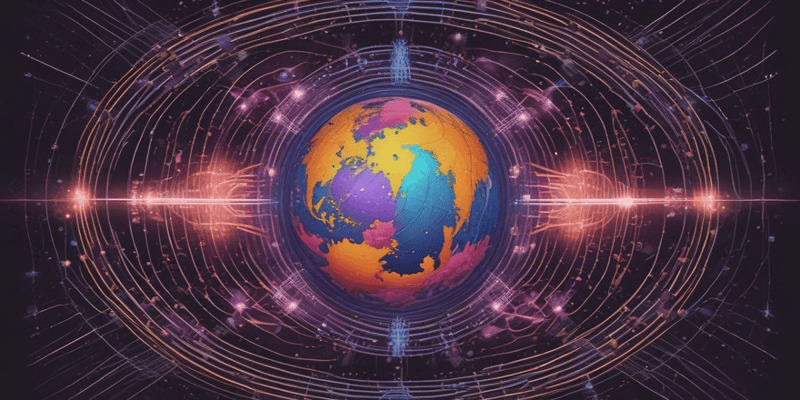Questions and Answers
What is the primary goal of particle physics?
To find and understand physics beyond the Standard Model
What are the two classifications of fundamental particles in the universe according to the Standard Model?
Fermions and bosons
What is the name of the particle that the Standard Model predicts the existence of?
Higgs boson
What is the primary difference between baryons and mesons?
Signup and view all the answers
What is the Large Hadron Collider (LHC) used for?
Signup and view all the answers
What is the proposed Future Circular Collider at CERN?
Signup and view all the answers
What is the primary limitation of the Standard Model of particle physics?
Signup and view all the answers
What are antiparticles?
Signup and view all the answers
What is the Particle Physics Project Prioritization Panel (P5) responsible for?
Signup and view all the answers
Study Notes
Particle Physics: Key Facts and Figures
-
Particle physics, or high energy physics, studies fundamental particles and forces that constitute matter and radiation.
-
The Standard Model classifies fundamental particles in the universe as fermions (matter particles) and bosons (force-carrying particles).
-
Quarks cannot exist on their own but form hadrons. Baryons contain an odd number of quarks, while mesons contain an even number.
-
Particle interactions are mediated by bosons, including electromagnetism, the weak interaction, and the strong interaction.
-
Antiparticles have the same mass as particles but opposite electric charges. They can form a corresponding form of matter called antimatter.
-
The dominant theory explaining fundamental particles and fields is called the Standard Model, which predicts the existence of a type of boson known as the Higgs boson.
-
Practical particle physics is the study of particles in radioactive processes and in particle accelerators, while theoretical particle physics is the study of particles in the context of cosmology and quantum theory.
-
The world's major particle physics laboratories are CERN, Fermilab, KEK, and DESY.
-
Theoretical particle physics attempts to develop models, theoretical frameworks, and mathematical tools to understand current experiments and make predictions for future experiments.
-
Practical applications of particle physics include medical isotopes, superconductors, and advances in technology such as the World Wide Web and touchscreen technology.
-
The primary goal of particle physics is to find and understand what physics may lie beyond the Standard Model, such as dark matter and neutrino mass.
-
Multiple Higgs factory proposals, consisting of lepton-lepton colliders with center of mass energy chosen to produce Higgs particles, are being developed to address rare signals in particle physics.The Future of Particle Physics
-
The Standard Model of particle physics is a well-established theory that describes the elementary particles and their interactions, but it has some limitations.
-
One of the limitations of the Standard Model is that it does not include a description of gravity.
-
The Large Hadron Collider (LHC) at CERN is a particle accelerator that is used to test the predictions of the Standard Model and search for new particles and interactions.
-
The Higgs boson, a particle predicted by the Standard Model, was discovered at the LHC in 2012.
-
The LHC is currently shut down for upgrades that will increase its luminosity and allow for more precise measurements and searches for new physics.
-
The proposed Future Circular Collider at CERN would be a 100 TeV proton collider, an order of magnitude more powerful than the LHC.
-
There are also non-collider experiments, such as the determination of neutrino masses and cosmological observations, that aim to find and understand physics beyond the Standard Model.
-
The Particle Physics Project Prioritization Panel (P5) began a new decadal study in 2023 to update the 2014 study that recommended the Deep Underground Neutrino Experiment and other experiments.
-
The study will consider the scientific opportunities and technological challenges of future particle physics experiments and facilities.
-
The study will also consider the international landscape of particle physics and the role of the US in the global effort.
-
The results of the study will inform the funding priorities of the US Department of Energy and the National Science Foundation for future particle physics research.
-
The future of particle physics is expected to be shaped by the results of the LHC upgrades, the development of new technologies, and the priorities of the global particle physics community.
Studying That Suits You
Use AI to generate personalized quizzes and flashcards to suit your learning preferences.
Description
Think you know the basics of particle physics? Test your knowledge with our quiz on key facts and figures in this fascinating field of study. From the Standard Model to particle interactions and the search for new physics beyond it, this quiz covers it all. Whether you're a student, enthusiast, or just curious about the world of particle physics, this quiz is sure to challenge and engage you. So, get ready to enter the world of subatomic particles and take our quiz now!




